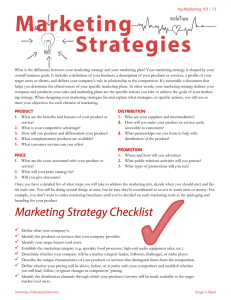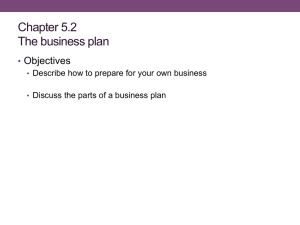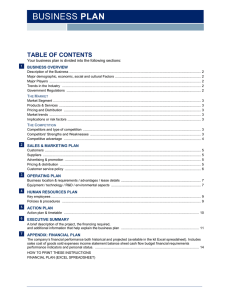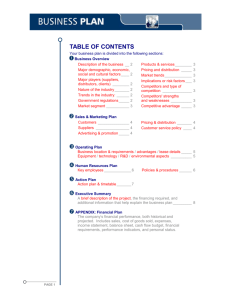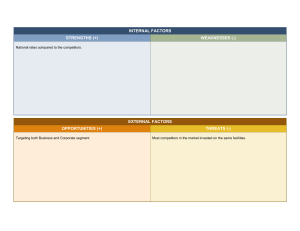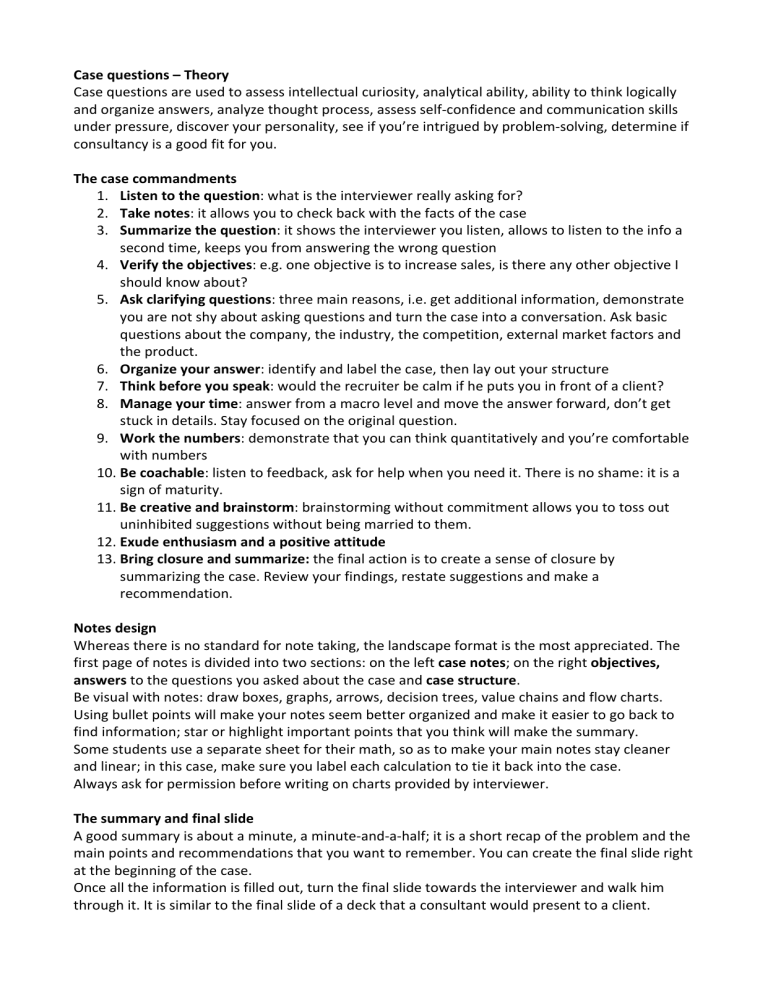
Case questions – Theory Case questions are used to assess intellectual curiosity, analytical ability, ability to think logically and organize answers, analyze thought process, assess self-confidence and communication skills under pressure, discover your personality, see if you’re intrigued by problem-solving, determine if consultancy is a good fit for you. The case commandments 1. Listen to the question: what is the interviewer really asking for? 2. Take notes: it allows you to check back with the facts of the case 3. Summarize the question: it shows the interviewer you listen, allows to listen to the info a second time, keeps you from answering the wrong question 4. Verify the objectives: e.g. one objective is to increase sales, is there any other objective I should know about? 5. Ask clarifying questions: three main reasons, i.e. get additional information, demonstrate you are not shy about asking questions and turn the case into a conversation. Ask basic questions about the company, the industry, the competition, external market factors and the product. 6. Organize your answer: identify and label the case, then lay out your structure 7. Think before you speak: would the recruiter be calm if he puts you in front of a client? 8. Manage your time: answer from a macro level and move the answer forward, don’t get stuck in details. Stay focused on the original question. 9. Work the numbers: demonstrate that you can think quantitatively and you’re comfortable with numbers 10. Be coachable: listen to feedback, ask for help when you need it. There is no shame: it is a sign of maturity. 11. Be creative and brainstorm: brainstorming without commitment allows you to toss out uninhibited suggestions without being married to them. 12. Exude enthusiasm and a positive attitude 13. Bring closure and summarize: the final action is to create a sense of closure by summarizing the case. Review your findings, restate suggestions and make a recommendation. Notes design Whereas there is no standard for note taking, the landscape format is the most appreciated. The first page of notes is divided into two sections: on the left case notes; on the right objectives, answers to the questions you asked about the case and case structure. Be visual with notes: draw boxes, graphs, arrows, decision trees, value chains and flow charts. Using bullet points will make your notes seem better organized and make it easier to go back to find information; star or highlight important points that you think will make the summary. Some students use a separate sheet for their math, so as to make your main notes stay cleaner and linear; in this case, make sure you label each calculation to tie it back into the case. Always ask for permission before writing on charts provided by interviewer. The summary and final slide A good summary is about a minute, a minute-and-a-half; it is a short recap of the problem and the main points and recommendations that you want to remember. You can create the final slide right at the beginning of the case. Once all the information is filled out, turn the final slide towards the interviewer and walk him through it. It is similar to the final slide of a deck that a consultant would present to a client. The Ivy Case System The first four steps: 1. Summarize the Question It allows you to hear the information again and keeps you from answering the wrong question. One word in the question can make a big difference in your answer. 2. Verify the Objectives There is always a possibility of an additional underlying objective. E.g. “One objective is to raise profits. Are there any other objectives that I should know about?” 3. Ask clarifying questions Questions are asked for three reasons: get additional information, show the interviewer you are not shy about asking questions and to turn the case into a conversation. The key is to ask broad, open-ended questions that help you narrow the information at the start. 4. Lay out your structure You tell the interviewer how you would go about fulfilling the company’s objectives and walk through the proposed steps. Many students find it helps to draw a decision tree, i.e. a map of the reasoning process visually breaking the case down into components and laying out the structure. It allows to review the options and investigate the possible outcomes, while weighing the risks and rewards of each course of action. 5. State your hypothesis For instance, if you get a profit and loss case, you might say “My hypothesis is that profits have fallen because costs have risen”; the advantages to stating a hypothesis up front are that it will help you ask the right questions, make your analysis more linear and force you to focus on issues that you can either prove or disprove. A simple trick to remind yourself to state a hypothesis is to lightly write the letter H in the middle of your first page of notes before you go into the interview. In some cases, you’ll be asked to analyze a company, in others to analyze the market or industry. Below are lists of core questions you should be thinking about and asking about the company and market/industry Company - It’s important to ask about the profit and revenue trends so you can get a feel for the size of the company and how it’s been doing. - Customer segmentation is critical: you need to know who the client’s customers are, so you can craft a strategy - Product mix: what products or services does the company offer and what are the costs and margins associated with each product? Have there been any recent changes in the product mix? - Production capabilities and capacity allow you to access several key areas. Does the company have the ability to expand? Are they running at full capacity now and if not, why not? - Brand: how strong is the brand? Is it a market leader or has the brand faded? - Distribution channel: how are the products and services currently distributed? Usually the more distribution channels the better Market - Market size, growth rate, trends. Ask for three years of data. How is the industry doing overall and how is the company growing compared with the industry? Industry drivers: is it brand, price, content, size, economics, technology, geopolitical events, bargaining power of buyers, bargaining power of suppliers or distribution channels? Customer segmentation: there are often a number of segments within an industry. Which is the company going after? How big are they? Industry changes: have there been any major changes within the industry, such as new players, mergers, new technology or new regulations? Distribution channels: what are the major distribution channels within the industry? Major players and market share: who are the competitors and how much market share do they have? Is it a fragmented market or one dominated by one or two major players? Product differentiation Barriers to entry Main four case scenarios 1. Profit and loss Whenever you hear the words bottom line, profits, costs or revenues, you should immediately think “Profits = (Revenues – Costs)”. E(P=R-C)M: E represents the economy, M represents the market or the industry. You always want to look at external factors first and know whether it is a company or industry-wide problem. Define the economic environment with your knowledge to set the framework of the case and take control of the interview. Go into the interview with some key economic factors memorized, such as unemployment rate, disposable income, consumer confidence, interest rates, the dollar’s strength in the currency market and gas prices. The M stands for industry: you’re not expected to know a lot about a particular industry, ask about industry trends and competitors to determine whether they are facing the same problems as the client. How has the client been doing compared with the rest of the industry? Going inside the parentheses is the same as going inside the company. Start by asking questions about the company: who are they? What do they do? What are their products? Market leader? Size in terms of revenues? Public or privately held? Trends in growth? Product mix? Customer segmentation? Key success factors? Review the revenue stream, important to analyze the situation and cut costs. Then, when you get to costs, ask “what are the major costs, both fixed and variable, and how have they changed over time?” The other parts of the profit-and-loss formula are price and volume. Price and volume are independent. You need to find the best mix, because changing one isn’t always the best answer. Once you have an understanding of the market, you’ll need to come up with solutions to raise profits. Start with headings, revenue-based strategies and cost-based strategies. If appropriate, divide your cost-based ideas into production, labor and finance. Questions to think about: • Revenues: what are the major revenue streams and what percentage of the total revenues does each stream represent? Does anything seem unusual in the balance of percentages? Have the percentages changed lately? If so, why? • Costs: any major shift in costs? Do any costs seem out of line? If we benchmarked our costs against our competitors’ cost, what would we find? Products: with new products, make sure you ask about the advantages and disadvantages. Disadvantages might be things like product cannibalization, layoffs, or in the case of a new drug side effects. Factors that impact price: market power, price elasticity, product differentiation, opportunities for differential pricing of the same product (e.g. airline seats), methods of pricing, brand power Factors that impact volume: - External factors: competition (market share, positioning, customers, profitability, differentiation), substitutes/complements, market forces (declining market size, technology, regulation), customers’ needs - Internal factors: distribution channels, manufacturing capacity, logistics/supply chain/inventory management - Growth strategies: sell more to existing customers; sell to new customers; sell new product to existing customers; sell new products to new customers Factors to consider when analyzing costs: fixed and variable costs, short-run vs. long-run costs, capacity utilization and impact on total average cost per unit, benchmark against competitors, relative percentage of cost components (COGS, operating costs, administrative costs). Costs will vary depending on the industry and it is important that you show you know where the bulk of the costs is. E.g. pharma: R&D; airlines: fixed costs 2. Entering a new market Useful to think about the 3 C’s (company, customers, competitors) and Porter’s five forces, without saying it explicitly. A good clarifying question when entering a new market is “Why does the company want to enter this market?” You should analyze the company first, then the market. This way, you can look at the new market through the company’s eyes and not just your own. Step 1: Start off with questions about the company. What are the company’s profits and revenues for the last three years? What is the company’s product mix? Will the new product cannibalize an existing one? Is the customer segmentation the same? Can we use the same distribution channel? Can we use the same sales force? Step 2: Determine the state of the current and future market. What is the size of the current market? What is the growth rate? Where is the industry in its life cycle (emerging? Mature? Declining?) Who are the customers and how are they segmented? What role does technology play in the industry and how quickly will it change? How will the competition respond? Step 3: Investigate the market to determine whether entry makes good business sense. Who are the competitors and what size market share do they have? How do their products differ from ours? How will we price our products or services? Are substitutions available? Are there any barriers to entry and exit? What are the risks (e.g. market regulation and technology)? Step 4: There are four major ways to enter a market 1. Start from scratch and grow organically 2. Acquire an existing player from within the industry 3. Form a joint venture/strategic alliance with another player with a similar interest. What can each side bring to the venture? 4. Outsourcing M&A: many questions about entering a new market are also M&A questions. The two most important factors about an M&A are whether it increases shareholder value and whether the two cultures will mesh well: cultural mismatch is the biggest reason mergers fail or don’t live up to their potential. If the buyer is a PE firm, ask “Why does the PE firm want to buy the company? What else does it own? And what does it plan to do with it?” If the M&A involves one company acquiring another, ask not only why, but also “What other products do they sell? Does the acquisition make good business sense?” Reasons to purchase include increase market access, boost the brand, increase market share, diversify the company’s holdings, pre-empt the competition from acquiring the company, acquire management talent, obtain patents or licenses, gain from synergies and cost savings, expand distribution channels, gain tax advantages. Due diligence à research the company and the industry: what kind of shape is the target company in? How secure are its markets, customers and suppliers? How is the industry doing overall? Is the company a leader? What are the margins like? How will competitors respond? Are there technological risks? Does the M&A create synergies? We want to understand if 1+1=3, 1+1=2 or 1+1=1 (destroy value) 3. Pricing strategies Investigate the company and its objectives, learn about the product or service and the competition, and then pick up a pricing strategy. Step 1: investigate the company. How big is it? What products does it have, and is it a market leader in its field? More importantly, what is the objective: profits, market share or brand positioning? Is it in charge of its own pricing strategy or is it reacting to suppliers, the market, and competitors? Company’s objectives are incredibly important: when Apple launched the iPad, it wanted high margins (à high price); Samsung, when launching the Galaxy tablet, wanted market share (à low price and lower margins); Amazon, when launching the Kindle, wanted to sell as many as possible because it makes money on ancillary sales (à low price, basically at cost). Step 2: Investigate the product. How does it compare with that of the competition? Are there substitutions or alternatives? Where is the product in its growth cycle? Is there a supply-anddemand issue at work? Step 3: Determine a pricing strategy. Three main pricing strategies: I. Competitive analysis: are there similar products out there? How does our product compare with the competition? Do we know the competitor’s costs? How are products priced? Are there substitutions available? II. Cost-based pricing: take all our costs, add them up, and add a profit to it. Usually not a very good way to price anything, though, because if you misjudge the market you’ll have to cut prices, which will squeeze margins – but the company needs to know what its costs are III. Price-based costing: what are the people willing to pay for this product? If they’re not willing to pay more than what it costs, then it might be not worth making. On the other hand, consumers may be willing to pay much more than you could get by just adding a profit margin. Profit margins vary greatly by industry: grocery stores have a very thin profit margin, while drug companies traditionally have a huge margin. Special note: don’t be constrained by percentages; there is nothing wrong with an 1,800 percent margin if that is what the market is willing to pay. However, if the product is a life-saving heart medication for babies, think of the public relations issues you might face Pricing questions become more difficult/interesting when you get a case about partition pricing – meaning that you charge separately for things like delivery, shipping, installation and warranties, versus bundling everything into one price. If you run an airline, do you advertise lower ticket prices and charge for baggage, or do you advertise that bags fly free and charge a higher ticket price? 4. Growth and Increasing Sales Increasing sales or growing the company is not the same as increasing profits. In the former case, you are less interested in costs. Still you want to have an understanding of the company and its objective, its product and the industry. Increasing sales can mean increasing volume, increasing revenues or both. Step 1: Learn about the company and its size, resources and products Step 2: Investigate the industry: is it growing and how is the client growing compared with the industry? Are the client’s prices in line with its competitors? Increase the volume: - Expand number of distribution channels - Increase product line through diversification of products or services - Analyze the segments of the business that have the highest future potential - Invest in a marketing campaign - Acquire a competitor (particularly if the question is about increasing market share) - Adjust prices (lower them to increase volume and raise them to decrease demand or increase profits) - Create a seasonal balance Another way for a company to grow is to find niches in developing industries with high barriers to entry. There will be less competition and more notice if someone is trying to enter. Possible ways to respond to an action by competitors: introduce a new product; increase our profile with a marketing and PR campaign; build customer loyalty; cut prices; lock-up raw materials and talent; acquire the competitor or another player in the same market; merge with a competitor to become more powerful; copy the competitor. The 12 cases scenarios 1. Entering a new market Step 1: Determine why. What is our goal? Objectives? Does it fit into our overall strategy? Step 2: Determine the state of the current and future market. a) What is the size of the market? b) What is the growth rate? c) Where is the company in its life cycle? d) Who are the customers and how are they segmented? e) What role does technology play in the industry and how quickly does it change? f) How will the competition respond? Step 3: Investigate the market to determine whether entry would make good business sense. a) Who is our competition and what size market share does each competitor have? b) How do their products and services differ from ours? c) How will we price our products or services? d) Are there substitutes available? e) Are there any barriers to entry and to exit? f) What are the risks? (e.g. market regulation or technology) Step 4: how would we enter the market? a) Start from scratch (greenfield investment) b) Acquire an existing player within the desired industry c) Form a joint venture/strategic alliance with another player with similar interests 2. Industry analysis Step 1: Investigate the industry overall (lifecycle, growth trends, performance relative to competitors, major players and market share, margins) Step 2: Investigate suppliers: have the suppliers been consistent? What’s going on in their industry? Will they continue to supply us? Step 3: What is the future outlook for the industry? a) Are players coming into or leaving the industry? b) Have there been many mergers or acquisitions lately? c) What are the barriers to entry and/or to exit? d) Will substitutes be introduced? 3. Mergers and Acquisitions Step 1: Determine the goals and objectives: Why are we buying? Is it a good strategic move? Reasons can be: a) Increase market access b) Diversify holdings c) Pre-empt the competition d) Gain tax advantages e) Incorporate synergies: marketing, financial, operational f) Create shareholder value Step 2: Due diligence. Research the company and industry a) What kind of shape is the company in? How secure are its markets, customers and suppliers? b) How is the industry doing overall? How is the company doing compared to the industry? c) What are the margin like? d) How will out competitors respond to this acquisition? e) Are there any legal reasons why we can’t, or should not, acquire? Step 3: How much are we paying? a) Is the price fair and can we afford it? b) How are we going to pay? c) If the economy sours, can they still make their debt payments? Step 4: Exit strategies, looking for a way out a) How long are they planning to keep it? b) Did they buy it to break it up and sell off parts of it? 4. Developing a new product Step 1: Think about the product a) What is special about the product? Is it patented? b) What are the disadvantages and advantages of this new product? c) How does it fit in with the rest of our product line? Step 2: Think about our market strategy a) How does it affect our existing product line? b) Are we cannibalizing one of our existing products? Are we replacing an existing product? c) How will this expand our customer base and increase our sales? d) Who are the major players and how much market share do they have? What will be their competitive response? e) If it’s a new market, what are the barriers to entering this market? Step 3: Think about our customers a) Who are our customers and how can we best reach them? b) How can we ensure that we can retain them? Step 4: Think about financing a) How is the project being funded and what is the best allocation of funds? b) Can we support the debt? 5. Pricing strategies Companies can use either cost-driven pricing or price-driven costing. Most American and European companies arrive at their price by adding up costs and then putting a profit margin on top. And then as soon as they have introduced the product, they have to start cutting the price, have to redesign the product at enormous expense and to take losses because the product was priced incorrectly. The only sound way to price is to start out with what the market is willing to pay and design to that price specification. Step 1: Investigate the product a) What is special or proprietary about the product? Are there similar products and how are they priced? b) Where are we in the growth cycle of this industry? c) How big is the market? d) What were our R&D costs? Step 2: Choose a pricing strategy. Is the company in control of the pricing strategy or is it responding to suppliers and competitors? a) Cost-based pricing vs. price-based costing b) How much does it cost to make and deliver the product? c) What does the market expect to pay? Is it a must have product? d) Do we need to spend money to educate the consumer? Step 3: Supply and demand a) What is the supply? How is the demand? b) How will pricing have an effect on the market equilibrium? In general, there are four main ways to price a product: Ø Competitive analysis: are there similar products out there? How does our product compare to the competition? Do we know their costs? Ø Cost-based pricing: Take all our costs, add them up and add a profit to it Ø Price-based costing: What are people willing to pay for this product? If they’re not willing to pay more than what it costs you to make, then it might not be worth making. Ø Company objective: Is the company interested in profits or market share? 6. Growth strategies Step 1: Growth strategies could mean focusing on a certain product, division or the company overall. a) Is the industry growing and how are we growing relative to the industry? b) Are our prices in line with our competitors? c) What have our competitors done in marketing and product development? d) Which segments of our business have the highest future potential? e) Do we have funding to support higher growth? Step 2: Choose a growth strategy. Increasing sales is one of the ways you grow, though not the only one. All or some of the following strategies for growth may fit the question: a) Increase distribution channels b) Increase product line c) Invest in a major marketing campaign d) Diversify products or services offered e) Acquire competitors or a company in a different industry 7. Starting a new business Step 1: Starting a new business encompasses entering a new market as well – the first step is the same. a) Who is our competition? What size market share does each competitor have? b) How do their products and services compare to ours? c) Are there any barriers to entry? These include: capital requirements, access to distribution channels, proprietary product technology or government policy Step 2: Look at the company from a venture capitalist point of view. Would you invest in this business? a) Management a. What is the management team like? b. What are its core competencies? Have they worked together before? c. Is there an advisory board? b) Market and strategic plans a. What are the barriers to entering this market? b. Who are the major players and what kind of market share does each company have? c. What will the competitive response be? c) Distribution channels: what are our distribution channels? d) Products a. What is the product or technology? b. What is the competitive edge? c. What are the disadvantages of this product? d. Is the technology proprietary? e) Customers a. Who are our customers? b. How can we reach and retain them? f) Finance: a. How is the project being funded? b. What is the best allocation of funds? c. Can we support the debt? 8. Competitive response How can we respond to an innovation introduced by a competitor? Step 1: We want to ask questions such as: a) What is the competitor’s new product and how does it differ from what we offer? b) What has the competitor done differently? What’s changed? c) Have any other competitors picked up market share? Step 2: Choose one of the following response actions: a) Acquire the competitor or another player in the same market b) Merge with a competitor to create a strategic advantage and make us more powerful c) Copy the competitor d) Hire the competitor’s top management e) Increase our profile with a marketing and public relations campaign 9. Increasing sales Step 1: Increasing sales does not necessarily mean increasing profits. Think about the relationship. What can be done? What do we need to know? a) How are we growing relative to the industry? b) What has our market share done lately? c) Have we gone out and asked customers what they want from us? d) Are our prices in line with competitors? e) What have our competitors done in marketing and product development? Step 2: There are four ways to increase sales. a) Increase volume à get more buyers, increase distribution channels, intensify marketing b) Increase amount of each sale à get each buyer to spend more c) Increase prices d) Create seasonal balance à increase sales in every quarter – if you own a nursery, sell flowers in the spring, herbs in the summer, pumpkins in the fall and trees and garlands in the winter 10. Reducing costs Step 1: Ask for a breakdown of costs Step 2: If any cost seems out of line, investigate why Step 3: Benchmark the competitors Step 4: Determine whether there are any labor-saving technologies that would help reduce costs If there has been a surge in costs, you need to focus on the internal and external costs that could account for the rise. For example, if labor costs have skyrocketed, is it because of the good economy and because good workers are hard to find? Or is it because the workforce has unionized? Examples of: Internal costs: union wages, suppliers, materials, economies of scale, increased support systems External costs: economy, interest rates, government regulations, transportation/shipping strikes 11. Improving the Bottom Line: Profits You always want to look at external factors first. Spell out your take on the current economy, which allows you to define the economic environment in which this case is taking place. This is a huge advantage because it reduces the number of surprises that the interviewer can throw at you. Then ask what the major revenue streams and costs are and how they have changed over time; it is always good to know trends. Try to determine whether there is an industry-wide problem or just a company problem. Once you have this information, you can decide whether you want to pump up the volume or cut costs to increase profits. In the first case, you can expand into new areas, increase sales force or marketing, reduce prices and improve customer service. 12. Turnarounds The company is in trouble and you have been brought in to save it. Step 1: Gather information a) Why is the company failing? Bad products, bad management, bad economy? b) What about the industry? Are our competitors facing the same problems? c) Do we have access to capital? d) Is it a public or privately-held company? Step 2: choose the appropriate actions from the following list. • Learn as much as possible about the business and its operations • Review services, products and finances (Are products out of date? Do we have a high debt load?) • Secure sufficient financing • Get rid of mediocre employees • Determine short-term and long-term goals • Devise a new business plan • Prioritize goals and get some small successes under your belt ASAP to build confidence Cost-driven pricing: the deadly business sin The only thing that works is price-driven costing; most companies arrive at their prices by adding up costs and then putting a profit margin on top. And then, as soon as they have introduced the product, they have to start cutting the price, have to redesign the product at enormous expense and to take losses – often at the end they have to drop a perfectly good product because it is priced incorrectly. The only sound way to price is to start out with what the market is willing to pay and design to that price specification. Cost-driven pricing is the reason there is no American consumerelectronics industry anymore: it had the technology and the products, but it operated on cost-led pricing – and the Japanese practiced price-led costing. Ways to cut costs Before answering, consider the company’s strategic needs and think about the long-term consequences of cuts under a range of various economic scenarios Labor 1. 2. 3. 4. 5. 6. Cross-train workers Cut overtime Reduce employer 401(k) or 403(b) match Raise employee contribution to health-care premium Institute four 10-hour days instead of five eight-hour days Convert workers into owners (if they have a stake in the company they will work longer and harder and constantly think of ways to cut costs) 7. Contemplate lay-offs 8. Institute across-the-board pay decreases Production 9. Invest in technology 10. Consolidate production space to gain scale and create accountability 11. Create flexible production lines 12. Reduce inventories (JIT) 13. Outsource 14. Renegotiate with suppliers 15. Consolidate suppliers 16. Import parts Finance 17. Have customers pay sooner 18. Refinance your debt 19. Sell non-essential assets 20. Hedge currency rates 21. Redesign health insurance Additional Tools and Frameworks Five C’s 1. Company: how big? Public or private? What kinds of products and services? 2. Costs: major costs? Have they changed? How do they compare to other players? How can we reduce them? 3. Competition: biggest competitors? Market share? Has it changed? Do we have any strategic advantage over competitors? 4. Clients: who are they? What do they want? Are we fulfilling their needs? How can we get more and retain those we have? 5. Channels: what are our distribution channels? How can we increase them? Are there areas we’re not reaching? How to reach them? Four P’s 1. Product: products and services? Company’s niche? 2. Price: how was price determined? Are we priced right? Effect of a price change on volume? 3. Place: how do we get our products to consumer? Can we reach more markets? Distribution channels? 4. Promotion: how can we best promote our product? Are we reaching the right market? Marketing campaign in the past? Effective? BCG Matrix Five forces analysis Useful when dealing with developing a new product, entering a new market or starting a new business. The value chain Questioning effectiveness and efficiencies of steps of the value chain not only shows an understanding of product flow, but can lead to relevant information that will help solve the case. Raw materials and inbound logistics à Operations à Delivery à Marketing and sales à Service If Scenarios to Remember Sales scenarios • If sales are flat and profits are decreasing, you need to examine both revenues and costs. Always start with the revenue side: until you identify and understand revenue streams, you cannot make decisions about costs. • If sales are flat but market share remains constant, industry sales may be flat too and your competitors may be experiencing similar problems. • If your case includes a decline-in-sales problem, analyze three things: o Overall declining market demand o Current marketplace is mature, or your product is obsolete o Loss of market share due to substitution • If sales and market share are increasing, but profits are declining, then you need to investigate whether prices are dropping and/or costs are climbing. However, if costs aren’t the issue, then investigate product mix and check to see if the margins have changed. Profit scenarios • If profits are declining because of a drop in revenues, concentrate on marketing and distribution issues • If profits are declining because of rising expenses, concentrate on operational and financial issues – i.e. COGS, labor, rent, marketing costs • If profits are declining, yet revenues are up, review changes in costs, any additional expenses, changes in prices, changes in the product mix, changes in customers’ needs. Product scenarios • If a product is in its emerging growth stage, concentrate on R&D, competition and pricing • If a product is in its growth stage, emphasize marketing and competition • If a product is in its mature stage, focus on manufacturing, costs and competition • If a product is in its declining stage, define niche market, analyze the competition’s play or think exit strategy. Pricing scenarios If you lower prices and volume rises, and you’re pushed beyond full capacity, your costs will shoot up as your employees work overtime, and consequently your profits will suffer. Prices are stable only when three conditions are met: the growth rate of all competitors is approximately the same; the prices are paralleling costs; prices of all competitors are roughly of equal value Case starts One mistake candidates often make is to quickly jump into calculating the market-size. Determining the market-size first is probably the right thing to do 80% of the time. However, you need to make sure that you have enough information to figure it out. If it is a new product, make sure you know the price. If you don’t, you can’t accurately determine market size. You’ll probably want to know about product differentiation as well. PRACTICE WITH CASE STARTS The pyramid principle https://www.preplounge.com/en/bootcamp.php/case-cracking-toolbox/structure-yourthoughts/pyramid-principle
